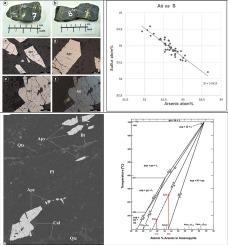Ore Geology Reviews ( IF 3.2 ) Pub Date : 2021-09-20 , DOI: 10.1016/j.oregeorev.2021.104482 Bibhuranjan Nayak 1 , Sven Sindern 2 , Thomas Wagner 2

|
The Mesoarchean Boula-Nuasahi ultramafic complex is situated in the south eastern flank of the Singhbhum Craton, India and consists mainly of gabbro-anorthosite, peridotite and pyroxenite litho-units that host a series of chromitite bodies. A contemporaneous but slightly younger magmatic event has structurally disturbed the area with intrusion of a coarse-grained gabbro unit known as the Bangur gabbro (∼3.1 Ga). This has caused extensive hydrothermal alteration of the original host rocks and is associated with hydrothermal sulphide- and Pt-Pd mineralizations. Petrographic study shows that well-crystallized and euhedral arsenopyrite crystals are associated with quartz and carbonates in veins aligned along the foliation planes/fractures in the host rocks. This vein assemblage (arsenopyrite + quartz + calcite) has formed during the late stage of hydrothermal mineralization. Electron probe micro-analysis and LA-ICP-MS analysis of arsenopyrite demonstrates that its chemical composition varies within narrow limits and that the concentrations of trace elements are below 900 ppm. The only trace element present in significant concentrations is Sb with an average value of 490 ppm. The As/S atomic ratio varies between 0.93 and 1.01 and As and S show a clear negative correlation according to the substitution FeAs1-xS1+x. The average composition is very close to the stoichiometric value. Because the arsenopyrite crystals are vein minerals, have very low concentrations of any impurities and do not show any compositional zoning, they were used for geothermometric calculations. Matching the measured As atom% with one of the experimentally calibrated isopleths in the established Fe-As-S phase diagram, calculated temperatures are in the range of 335–425 °C. This temperature range is in very good agreement with temperature estimates of 300–500 °C (based on cobaltite–gersdorffite compositions) for late-stage hydrothermal mineralization in the Boula-Nuasahi ultramafic complex available in the literature.
中文翻译:

印度奥里萨邦中太古代 Boula-Nuasahi 超镁铁杂岩中晚期热液成矿的形成:来自毒砂地球测温和微量元素数据的约束
中古宙 Boula-Nuasahi 超镁铁质杂岩体位于印度 Singhbhum Craton 的东南侧,主要由辉长岩-斜长岩、橄榄岩和辉石岩组成,这些岩性单元包含一系列铬铁矿体。一个同时发生但稍年轻的岩浆事件在结构上扰动了该地区,侵入了一种被称为班古尔辉长岩 (~3.1 Ga) 的粗粒辉长岩单元。这导致了原始主岩的广泛热液蚀变,并与热液硫化物和 Pt-Pd 矿化有关。岩相学研究表明,结晶良好和自形的毒砂晶体与沿主岩叶理面/裂缝排列的脉中的石英和碳酸盐有关。该脉组合(毒砂+石英+方解石)形成于热液成矿后期。毒砂的电子探针微量分析和 LA-ICP-MS 分析表明,其化学成分在很窄的范围内变化,并且痕量元素的浓度低于 900 ppm。唯一以显着浓度存在的痕量元素是 Sb,其平均值为 490 ppm。As/S 原子比在 0.93 和 1.01 之间变化,并且 As 和 S 根据取代 FeAs 显示出明显的负相关 唯一以显着浓度存在的痕量元素是 Sb,其平均值为 490 ppm。As/S 原子比在 0.93 和 1.01 之间变化,并且 As 和 S 根据取代 FeAs 显示出明显的负相关 唯一以显着浓度存在的痕量元素是 Sb,其平均值为 490 ppm。As/S 原子比在 0.93 和 1.01 之间变化,并且 As 和 S 根据取代 FeAs 显示出明显的负相关1-x S 1+x。平均组成非常接近化学计量值。由于毒砂晶体是脉状矿物,任何杂质的浓度都非常低,并且没有显示任何成分区带,因此它们被用于地热计算。将测得的 As atom% 与已建立的 Fe-As-S 相图中的实验校准等值线之一相匹配,计算出的温度范围为 335–425 °C。该温度范围与文献中可用的 Boula-Nuasahi 超基性复合体中后期热液矿化的 300-500 °C(基于钴酸钙-gersdorfite 成分)的温度估计值非常一致。











































 京公网安备 11010802027423号
京公网安备 11010802027423号